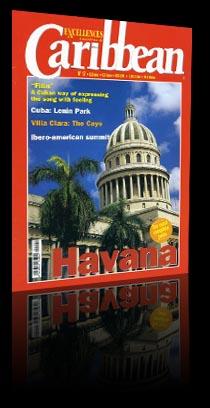Guide. La habana
Cuba, the Large Island as is also known, provides the visitors with a wide range of tourism offers that can meet all kind of interests. Havana, its capital, is a faithful example of this intensity because it merges its charming people and its streets. Getting there Located at the entrance of the Gulf of Mexico, the Cuban archipelago comprised the Isle of Cuba, the Isle of Youth (Isla de la Juventud) and approximately 4,195 cays and islets. The silhouette of Cuba, long and narrow, is 1,200 km long and its width ranges between 32 and 145 km. As a total, the territory covers some 110,922 km2 which is what distinguishes this island from the others as the largest of the Antilles. You can arrive to Cuba through airlines such as Iberia, Air Europe and Spanair from Spain and also by the very emblematic Cuban airline Cubana de Aviación operating in the main cities of Europe and The Americas. They all regularly fly to the island.
Getting around Cuba Regular flights and charters from national airlines fly to all Cuban provinces and cays of the archipelago as well. The size and shape of the country allow to travel by car, bus or taxi heading to any province by the National High Way, the Central Road and other means of communication. Also Cuban Railroads links all the provinces with the capital.
Car rentals Standard, economical and deluxe vehicles can be rented at airports, hotels and tourism resorts along the whole country. Driving license and passport are indispensable documents. International traffic signs are in force.
Currency Though the Cuban peso is the national currency, the US dollar is used all over the Cuban territory to pay for all tourism-related services. Also the convertible peso, a currency equivalent to the dollar, circulates and is used to pay in dollar establishments only valid in Cuba. There are places to change dollars into Cuban pesos by the name of Cadecas whose main office is in Lamparilla 4, Old Havana. Phone: 66 9628.
How to pay In cash and with credit cards as Visa International, MasterCard, Access, Bancomer International, Eurocard, Banamex Dinners Club International, Cabal, JCB and Carnet, traveler's checks and vouchers. Cards issued by the banks in the United States and its branches are not allowed. The prices for meals and beverages vary depending on the place.
HEALTH SERVICES In the health sector, Cuba can be compared to the most developed countries with a wide infrastructure of hospitals, dispensaries and ambulatory services and clinics and others related services which can be found all over the cities and rural areas.
Shopping There are stores in all the hotels and several chains of establishments that allow visitors to purchase personal articles, confectionery, crafts and souvenirs, rum, cigar and music.
Feasts and Festivals Cuba is the venue of major festivals as the Nuevo Cine Latinoamericano (New Latin-American Cinema), Internacional de Ballet de La Habana (Havana's International Ballet), Biennial of Humorism of San Antonio de los Baños, Premio Casa de Las Américas (Casa de Las Américas Literary Contest), Fiesta de la Cultura Caribeña (Caribbean Culture Feast), la Jornada de la Cultura Cucalambeana (Week for the Cucalambeana Culture), carnivals and traditional parrandas (local feasts).
Where to eat There are many light food services and restaurants of international cuisine. Typical Cuban dishes par excellence are pork in its varieties: fried, roast or with sauce (fricassee). In relation to rice, moros y cristianos (a mixture of rice and black beans); yucca and fried roots-tachino (fried green plantain rounds), chicharritas (green plantain chips), french fries and fired sweet potato-vegetable salads; ajiaco (a pot made of vegetables, roots, greens and meat); home-made desserts (coconut, mango and papaya) with cheese.
Not-to-be missed Places that must be visited in Havana are: Los Tres Reyes del Morro, La Cabaña and La Punta castles, the Basílica Menor de San Francisco de Asís (16th century) and the Cathedral of Havana. The General Captain Palace located in Arms Square where important items of the history of Cuba are on display. Revolution Square has a monument complex in honor to the Hero of Independence, José Martí. Museums to be visited are: Colonial Art Museum, an old colonial mansion located at Cathedral Square where works of art are exhibited, as well as furnitures and other decorative artifacts of a colonial style. The Museum of the Revolution in the old Presidential Palace building where items of great historic value are exhibited from the independent wars and the revolutionary war, situated in the old Palacio Presidencial, Calle Refugio Nº 1, Old Havana. Ernest Hemingway Museum at Finca Vigía, San Francisco de Paula, became a house-museum after the writer's death who lived in Cuba during his last 22 years of life. Among the theaters not to be missed are the Gran Teatro de La Habana featuring ballet and opera at Paseo del Prado y San Rafael, or the National Theater at Revolution Square, where the National Symphonic Orchestra has a wide program and international festivals Where to go A wide range of excursions and optional activities are offered within the tourism package or bought in tourism bureaus. Tours are organized to see historic and cultural sites, national parks, museums, excursions to the cays, water activities, among other options that make your stay even more pleasant.






























































